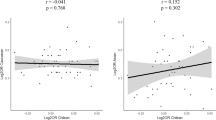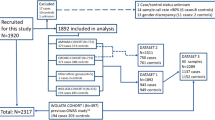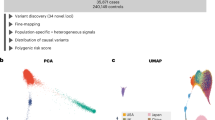Abstract
Complement factor H (CFH) is an essential regulator in the homeostasis of the complement system that plays multiple roles in leprosy. We previously reported a preliminary association of CFH with leprosy, but potentially causal variants remain to be identified. In this study, we performed a fine-mapping association analysis in 1110 individuals (527 leprosy patients and 583 controls) followed by bioinformatic analyses. We identified no association of typical missense CFH variants with leprosy and factor H-binding protein was not detected in Mycobacterium leprae. However, robust associations (PBonferroni<0.003) of several CFH intronic tag single-nucleotide polymorphisms with leprosy were observed. Expression quantitative trait locus analysis showed that these leprosy-protective alleles were associated with higher CFH level and lower CFHR3 (complement factor H-related 3) level. Our results indicated that CFH variants may contribute to leprosy pathogenesis through altering CFH expression, leading to regulation of complement activity rather than mediating immune evasion by bacteria binding.
This is a preview of subscription content, access via your institution
Access options
Subscribe to this journal
Receive 6 digital issues and online access to articles
$119.00 per year
only $19.83 per issue
Buy this article
- Purchase on Springer Link
- Instant access to full article PDF
Prices may be subject to local taxes which are calculated during checkout


Similar content being viewed by others
References
Alter A, Alcais A, Abel L, Schurr E . Leprosy as a genetic model for susceptibility to common infectious diseases. Hum Genet 2008; 123: 227–235.
Ricklin D, Hajishengallis G, Yang K, Lambris JD . Complement: a key system for immune surveillance and homeostasis. Nat Immunol 2010; 11: 785–797.
Schlesinger LS, Horwitz MA . Phagocytosis of leprosy bacilli is mediated by complement receptors CR1 and CR3 on human monocytes and complement component C3 in serum. J Clin Invest 1990; 85: 1304–1314.
Rodríguez de Córdoba S, Esparza-Gordillo J, Goicoechea de Jorge E, Lopez-Trascasa M, Sánchez-Corral P . The human complement factor H: functional roles, genetic variations and disease associations. Mol Immunol 2004; 41: 355–367.
Rooijakkers SH, van Strijp JA . Bacterial complement evasion. Mol Immunol 2007; 44: 23–32.
Zhang D-F, Huang X-Q, Wang D, Li Y-Y, Yao Y-G . Genetic variants of complement genes ficolin-2, mannose-binding lectin and complement factor H are associated with leprosy in Han Chinese from Southwest China. Hum Genet 2013; 132: 629–640.
Hahn LW, Ritchie MD, Moore JH . Multifactor dimensionality reduction software for detecting gene-gene and gene-environment interactions. Bioinformatics 2003; 19: 376–382.
Beernink PT, Granoff DM . The modular architecture of meningococcal factor H-binding protein. Microbiology 2009; 155: 2873–2883.
Goicoechea de Jorge E, Caesar JJ, Malik TH, Patel M, Colledge M, Johnson S et al. Dimerization of complement factor H-related proteins modulates complement activation in vivo. Proc Natl Acad Sci USA 2013; 110: 4685–4690.
Davila S, Wright VJ, Khor CC, Sim KS, Binder A, Breunis WB et al. Genome-wide association study identifies variants in the CFH region associated with host susceptibility to meningococcal disease. Nat Genet 2010; 42: 772–776.
Wang D, Feng JQ, Li YY, Zhang DF, Li XA, Li QW et al. Genetic variants of the MRC1 gene and the IFNG gene are associated with leprosy in Han Chinese from Southwest China. Hum Genet 2012; 131: 1251–1260.
Purcell S, Neale B, Todd-Brown K, Thomas L, Ferreira MA, Bender D et al. PLINK: a tool set for whole-genome association and population-based linkage analyses. Am J Hum Genet 2007; 81: 559–575.
Liu JZ, McRae AF, Nyholt DR, Medland SE, Wray NR, Brown KM et al. A versatile gene-based test for genome-wide association studies. Am J Hum Genet 2010; 87: 139–145.
Bleharski JR, Li H, Meinken C, Graeber TG, Ochoa MT, Yamamura M et al. Use of genetic profiling in leprosy to discriminate clinical forms of the disease. Science 2003; 301: 1527–1530.
Dezső Z, Nikolsky Y, Sviridov E, Shi W, Serebriyskaya T, Dosymbekov D et al. A comprehensive functional analysis of tissue specificity of human gene expression. BMC Biol 2008; 6: 49.
Acknowledgements
This work was supported by the National Natural Science Foundation of China (31271346 and 81260237) and the Chinese Academy of Sciences.
Author information
Authors and Affiliations
Corresponding authors
Ethics declarations
Competing interests
The authors declare no conflict of interest.
Additional information
Supplementary Information accompanies this paper on Genes and Immunity website
Supplementary information
Rights and permissions
About this article
Cite this article
Zhang, DF., Wang, D., Li, YY. et al. Mapping genetic variants in the CFH gene for association with leprosy in Han Chinese. Genes Immun 15, 506–510 (2014). https://doi.org/10.1038/gene.2014.43
Received:
Revised:
Accepted:
Published:
Issue Date:
DOI: https://doi.org/10.1038/gene.2014.43
This article is cited by
-
Identification of novel genetic loci GAL3ST4 and CHGB involved in susceptibility to leprosy
Scientific Reports (2017)
-
CFH Variants Affect Structural and Functional Brain Changes and Genetic Risk of Alzheimer’s Disease
Neuropsychopharmacology (2016)
-
Association of the LRRK2 genetic polymorphisms with leprosy in Han Chinese from Southwest China
Genes & Immunity (2015)



